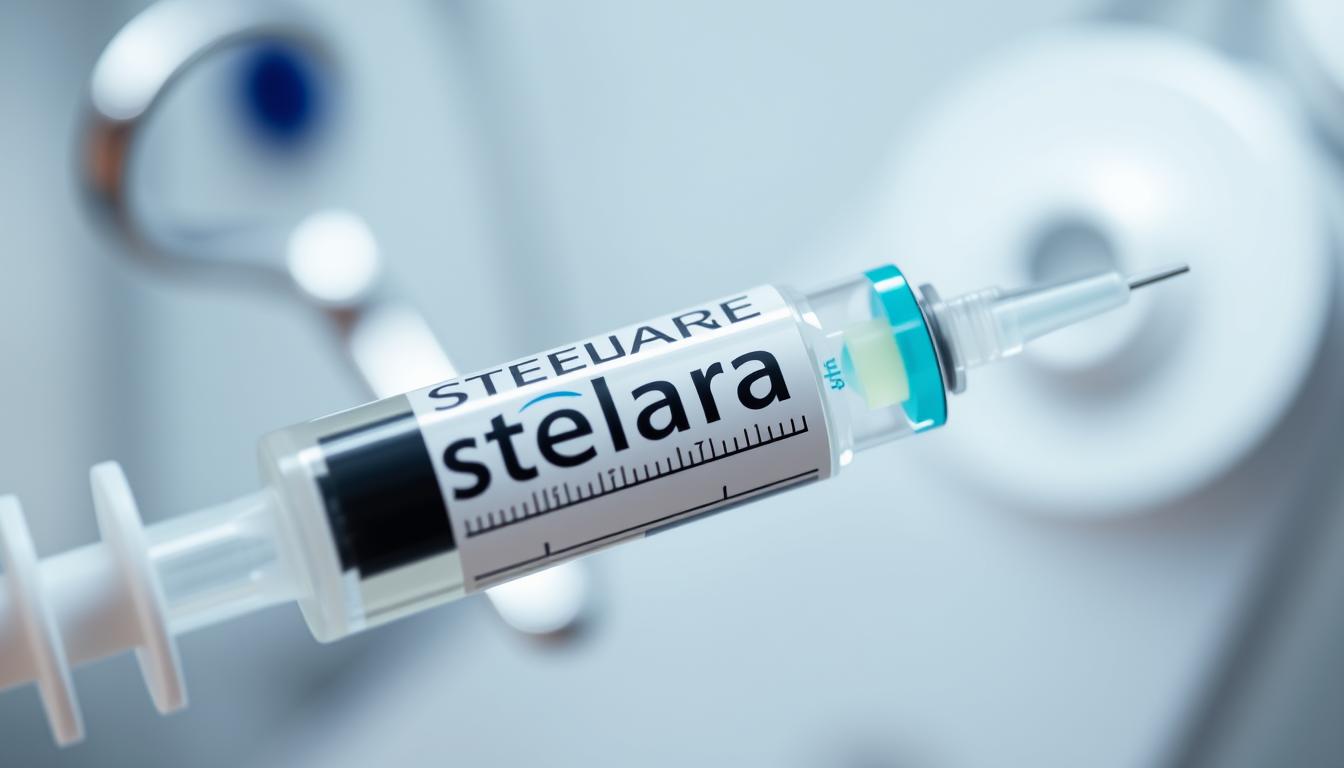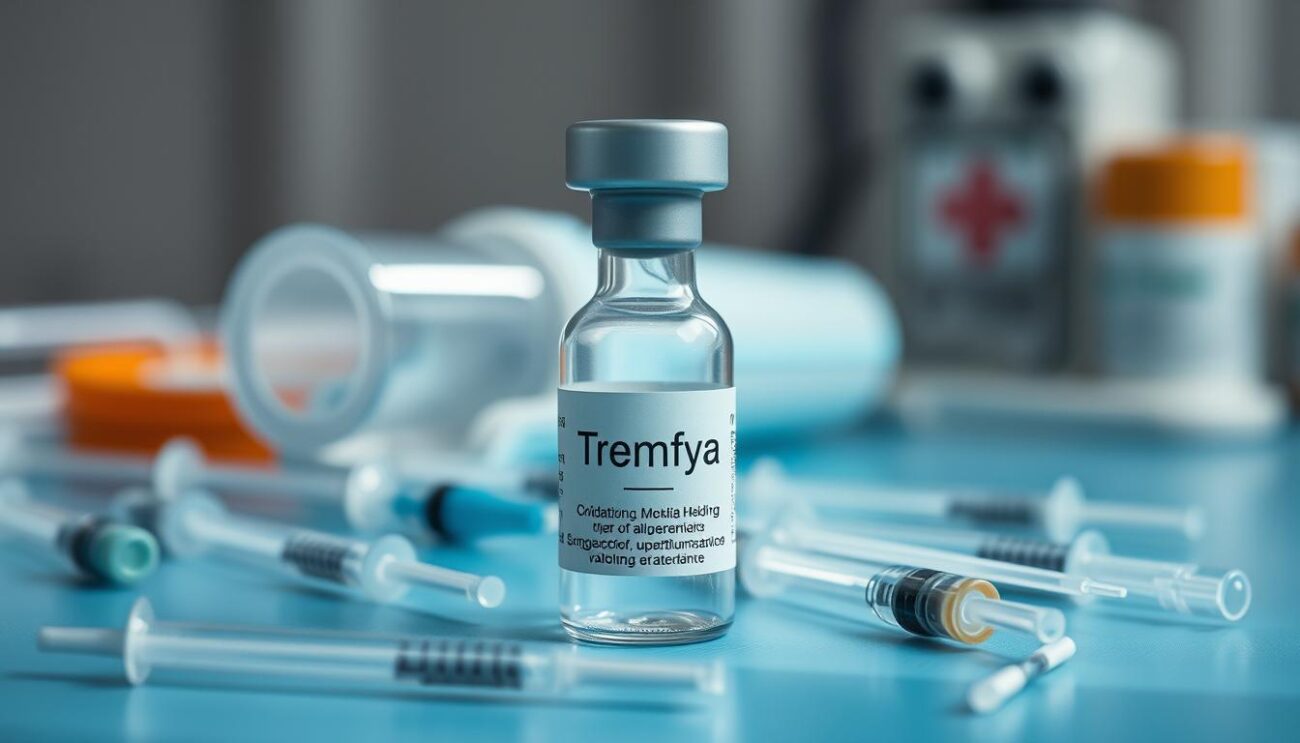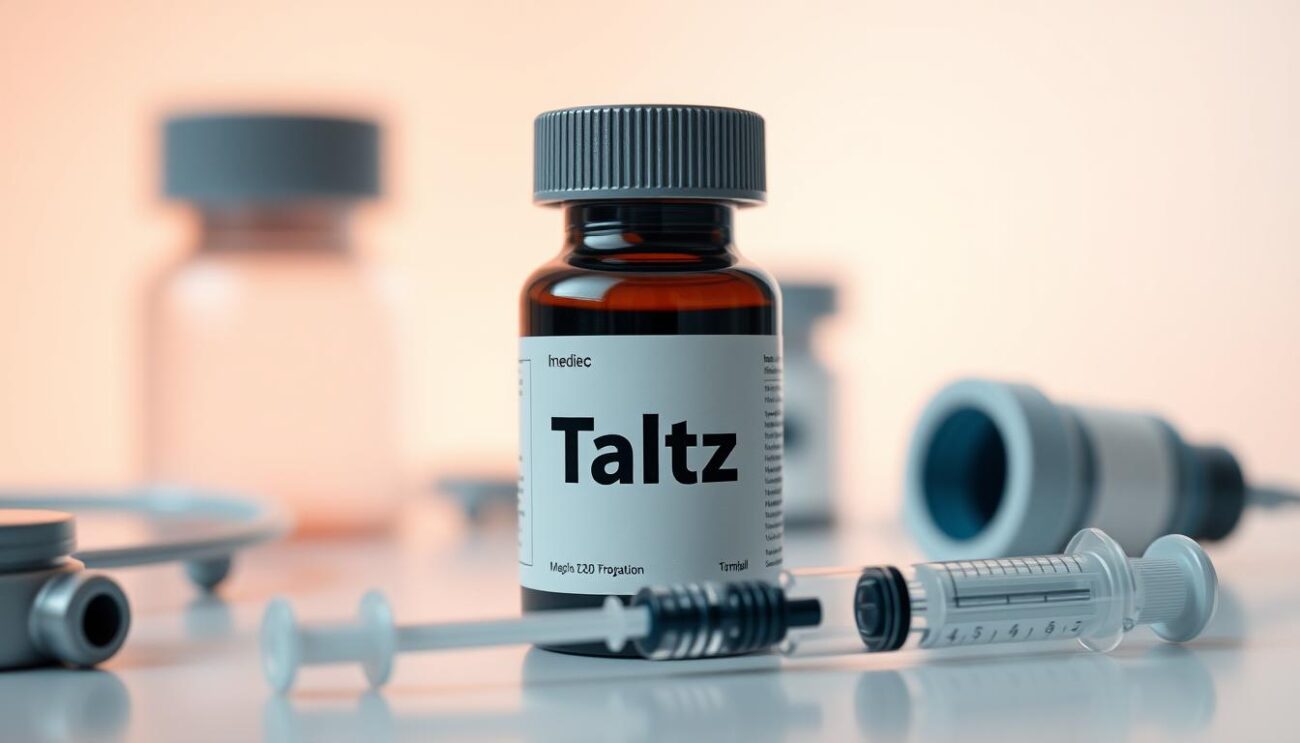Are you curious about Stelara, the injectable medication? It’s a prescription drug used for many autoimmune disorders. These include plaque psoriasis, psoriatic arthritis, Crohn’s disease, and ulcerative colitis. But what does it do, and what should you know before using it?
Stelara works by targeting IL-12 and IL-23 proteins. These proteins are linked to inflammation in autoimmune conditions. By blocking them, Stelara helps manage symptoms and reduce inflammation.
Key Takeaways
- Stelara is a biologic medication used to treat plaque psoriasis, psoriatic arthritis, Crohn’s disease, and ulcerative colitis.
- It works by targeting the IL-12 and IL-23 proteins, which are thought to play a key role in the inflammation underlying these autoimmune conditions.
- Stelara is administered through an intravenous (IV) infusion followed by subcutaneous injections every 8 weeks.
- Common side effects include injection site reactions, headaches, and upper respiratory infections, while serious side effects may include severe infections and a rare condition called PRES.
- Patients taking Stelara should be monitored carefully and report any concerning symptoms to their healthcare provider.
What is Stelara?
Stelara (ustekinumab) is a biologic medication. It works as an immunosuppressant by targeting IL-12 and IL-23 proteins. These proteins are linked to inflammation in autoimmune conditions. It’s approved for treating plaque psoriasis, psoriatic arthritis, Crohn’s disease, and ulcerative colitis.
Overview and Key Facts
Stelara’s main ingredient is ustekinumab, a human monoclonal antibody. It binds to and blocks IL-12 and IL-23. This anti-IL-12/23 action makes Stelara a special biologic therapy for these autoimmune diseases.
Active Ingredient: Ustekinumab
Each vial of Stelara has 130 mg of ustekinumab in a 26 mL (5 mg/mL) solution. It’s for intravenous use. The initial dose depends on the patient’s weight.
| Patient Weight | Recommended Initial Intravenous Dose |
|---|---|
| ≤55 kg | 260 mg |
| >55 kg to ≤85 kg | 390 mg |
| >85 kg | 520 mg |
Stelara starts with a single intravenous dose. Then, a subcutaneous dose is given at week 8. Elderly patients (≥65 years) don’t need dose adjustments.
“Stelara has not been studied in patients with renal and hepatic impairment, and no dose recommendations are available.”
Approved Uses for Stelara Injection
Stelara injection is a biologic medication with the active ingredient ustekinumab. It has been approved by the FDA for treating plaque psoriasis and psoriatic arthritis in adults. This medication works by addressing the immune system issues that cause these diseases.
Plaque Psoriasis Treatment
Stelara can be a big help for those with plaque psoriasis. It targets IL-12 and IL-23 cytokines to reduce the red, scaly skin patches. Adults with plaque psoriasis start with a 45 mg injection, then another 45 mg dose 4 weeks later. After that, they get 45 mg every 12 weeks.
Psoriatic Arthritis Treatment
Stelara is also approved for psoriatic arthritis in adults. It helps reduce joint pain and swelling, and improves joint function. Adults with psoriatic arthritis get a 45 mg injection every 12 weeks.
Stelara is a great option for treating both plaque psoriasis and psoriatic arthritis. It offers targeted anti-inflammatory therapy. This can bring much-needed relief to those managing these complex autoimmune disorders.
How Does injection stelara Work?
Stelara, also known as ustekinumab, is a new kind of treatment for autoimmune diseases. It works by blocking the action of certain proteins that cause inflammation. This helps reduce the immune system’s overactive response in diseases like psoriasis and Crohn’s disease.
Targeting IL-12 and IL-23
Stelara works by binding to and stopping two proteins: interleukin-12 (IL-12) and interleukin-23 (IL-23). These proteins are key players in inflammation that leads to autoimmune diseases.
- IL-12 and IL-23 make the immune system too active, causing too much inflammation and damage.
- By stopping IL-12 and IL-23, Stelara reduces inflammation and brings the immune system back into balance.
- This action helps lessen the symptoms and slow the disease in conditions like psoriasis and Crohn’s disease.
Stelara’s ability to target IL-12 and IL-23 marks a big step forward in treating autoimmune diseases. It offers a more effective and anti-inflammatory way to treat these conditions compared to older treatments.
Benefits of Stelara for Crohn’s Disease
Living with Crohn’s disease, an autoimmune disorder, can be tough. Stelara, a biologic medication, offers hope for those affected. It’s a promising treatment for managing this condition.
Symptom Improvement Timeline
Studies show that many patients with Crohn’s disease see symptom improvement in just 3 weeks after their first Stelara infusion. Most patients reach remission within a year of ongoing treatment. This quick response is thanks to Stelara’s unique way of working.
Stelara targets IL-12 and IL-23 proteins, key players in gastrointestinal inflammation and autoimmune disorders like Crohn’s disease and ulcerative colitis. It helps manage symptoms and slow disease progression. This offers new hope to those dealing with this chronic condition.
“Stelara has been a game-changer for me. Within just a few weeks of starting treatment, my Crohn’s symptoms started to improve, and I was able to achieve long-term remission. It’s truly life-changing.”
Stelara’s targeted approach and proven success make it a popular choice for Crohn’s disease treatment. As research grows, more healthcare providers and patients see the benefits Stelara offers in managing this autoimmune condition.
Administration and Dosing
Stelara is used to treat plaque psoriasis and psoriatic arthritis. It comes in two forms: intravenous (IV) infusion and subcutaneous injection. The dose depends on the condition and the patient’s weight.
Intravenous (IV) Infusion
The first dose is given as an IV infusion. This takes about 1 hour. A healthcare professional will do it.
Subcutaneous Injections
After the first IV, patients get injections every 8 weeks. They can do these at home after training. The dose is based on weight, with 45 mg for those under 100 kg and 90 mg for more.
| Medication | Dosing Regimen | Dose |
|---|---|---|
| Stelara (Plaque Psoriasis) | Subcutaneous injection every 12 weeks | 45 mg for individuals ≤100 kg 90 mg for individuals >100 kg |
| Stelara (Psoriatic Arthritis) | Subcutaneous injection every 12 weeks | 45 mg |
| Stelara (Crohn’s Disease/Ulcerative Colitis) | Subcutaneous injection every 8 weeks | 90 mg, regardless of weight |
It’s key to stick to the dosing and administration plan for Stelara. If you have questions, talk to your healthcare provider.
Safety and Side Effects
Patients taking Stelara injections should know about common and serious side effects. Knowing these risks helps people make better treatment choices. It also keeps them talking openly with their doctors.
Common Side Effects
The most common side effects of Stelara include:
- Nasal congestion
- Sore throat
- Runny nose
- Upper respiratory infections
- Fever
- Headache
- Fatigue
- Itching
- Nausea
- Vomiting
- Redness at the injection site
Serious Side Effects
Stelara can also lead to serious side effects, though they are less common. These include:
- Increased risk of infections
- Certain types of cancers
- Allergic reactions
- A rare condition called posterior reversible encephalopathy syndrome (PRES)
If you notice new or worsening symptoms while on Stelara, tell your doctor right away. Quick action can help manage these safety concerns.
“Monitoring for potential side effects is crucial when using Stelara, as it helps ensure the safe and effective use of this medication.”
Stelara as a Biologic Therapy
Stelara is a biologic medication made from living cells. It targets specific parts of the immune system. As an immunosuppressant, it works by blocking IL-12 and IL-23 proteins. These proteins are involved in the inflammation seen in autoimmune disorders like psoriasis and Crohn’s disease.
By controlling the immune response, Stelara helps manage symptoms. It treats chronic, anti-inflammatory conditions.
Targeting Inflammation
Stelara is unique because it targets both IL-12 and IL-23. These proteins are key in gastrointestinal inflammation, especially in Crohn’s disease. This targeted approach helps many patients, with most seeing symptom improvement in 3-6 weeks.
Remission is often achieved within the first year of treatment.
| Autoimmune Disorder | Stelara Dosage | Common Side Effects |
|---|---|---|
| Plaque Psoriasis | 45 mg or 90 mg every 12 weeks | Nasopharyngitis, upper respiratory infection, headache, fatigue |
| Psoriatic Arthritis | 45 mg every 12 weeks | Nasopharyngitis, injection site erythema, bronchitis |
| Crohn’s Disease | Intravenous infusion followed by 90 mg every 8 weeks | Nasopharyngitis, injection site erythema, vulvovaginal candidiasis, bronchitis |
Stelara’s targeted action and proven results make it a key biologic therapy. It’s used to manage various chronic, autoimmune disorders and their inflammation.
Long-term Use and Research
Stelara, also known as ustekinumab, has been studied for over a decade. It has shown to be effective and safe for managing Crohn’s disease and psoriasis over time.
Years of Clinical Research
Stelara’s research is vast, with many studies and trials. Over 1,281 patients took part in Phase 3 studies for Crohn’s disease. An impressive 86.5% of them finished the 96-week study.
These studies found that patients kept getting better from Week 44 to Week 92. This was true across different treatment groups.
Patient Treatment Numbers
- More than 121,000 patients have been treated with Stelara for Crohn’s disease and ulcerative colitis in the United States alone.
- Real-world data also supports Stelara’s long-term benefits. Studies show consistent improvements in Crohn’s disease patients over years.
Stelara’s long-term use has shown promise in managing chronic conditions like Crohn’s disease and psoriasis.
| Study | Key Findings |
|---|---|
| Sandborn et al. 2016 | Ustekinumab was effective as induction and maintenance therapy for Crohn’s disease. |
| Hazlewood et al. 2015 | Conducted a comparative analysis of immunosuppressants and biologics for inducing and maintaining remission in Crohn’s disease. |
| Aliment Pharmacol Ther 2018 | Highlighted the long-term efficacy and safety of ustekinumab for Crohn’s disease through the second year of therapy. |
Discussing Treatment with Your Doctor
Talking openly with your doctor about Stelara treatment is key. They can decide if Stelara fits your needs. Together, you can create a detailed treatment plan.
Good doctor-patient communication leads to better results. Discussing Stelara’s benefits and risks is important. This way, you and your doctor can make a choice that meets your goals.
Don’t hesitate to ask about Stelara and your current medication management. Your doctor can guide you on the right dosage and how to use it. This ensures your safety and health.
It’s vital to work together when thinking about Stelara or other biologic therapies for autoimmune disorders. A team effort helps create a plan that suits you best. This way, you can reach your health goals.
“Effective communication and a collaborative approach between the patient and healthcare provider is crucial for achieving the best possible outcomes.”
Patient Support Programs
For those with commercial or private insurance, patient support programs can help with Stelara costs. These programs offer cost savings, making treatment more affordable. But, they don’t help those with Medicare, Medicaid, or government insurance.
Eligibility and benefits can change each year. It’s key to talk to your doctor or the program to know the latest details. These programs can help make treatment more affordable, easing the financial stress.
Cost Savings for Eligible Patients
Patient support for Stelara can save a lot of money for those with commercial or private insurance. These programs might cover some costs like deductibles or copays. It’s a good idea to check with your doctor or the program to see if you qualify and how much help you can get.
- Eligible patients with commercial or private insurance may qualify for cost savings through patient support programs.
- These programs do not apply to individuals with Medicare, Medicaid, or other government-funded insurance plans.
- The specific eligibility requirements and maximum program benefits can change annually, so patients should check with their healthcare provider or the program directly for the most up-to-date information.

“By utilizing patient support programs, eligible individuals can access the Stelara treatment they need while minimizing the financial burden.”
Conclusion
Stelara (ustekinumab) is a groundbreaking biologic drug. It has changed how we treat autoimmune diseases like plaque psoriasis and Crohn’s disease. By targeting IL-12 and IL-23, Stelara tackles the root causes of these conditions.
This leads to a big drop in symptoms and improves patients’ lives. The research on Stelara shows it’s safe and works well over time. Most patients see a big decrease in their symptoms.
Stelara can be given through an IV or shots under the skin. It’s a flexible and dependable treatment for those with these diseases.
Before starting Stelara, patients should talk to their doctor about the good and bad sides. Knowing how Stelara works and its uses helps patients make smart choices. They can then work with their doctors to get the best results.







